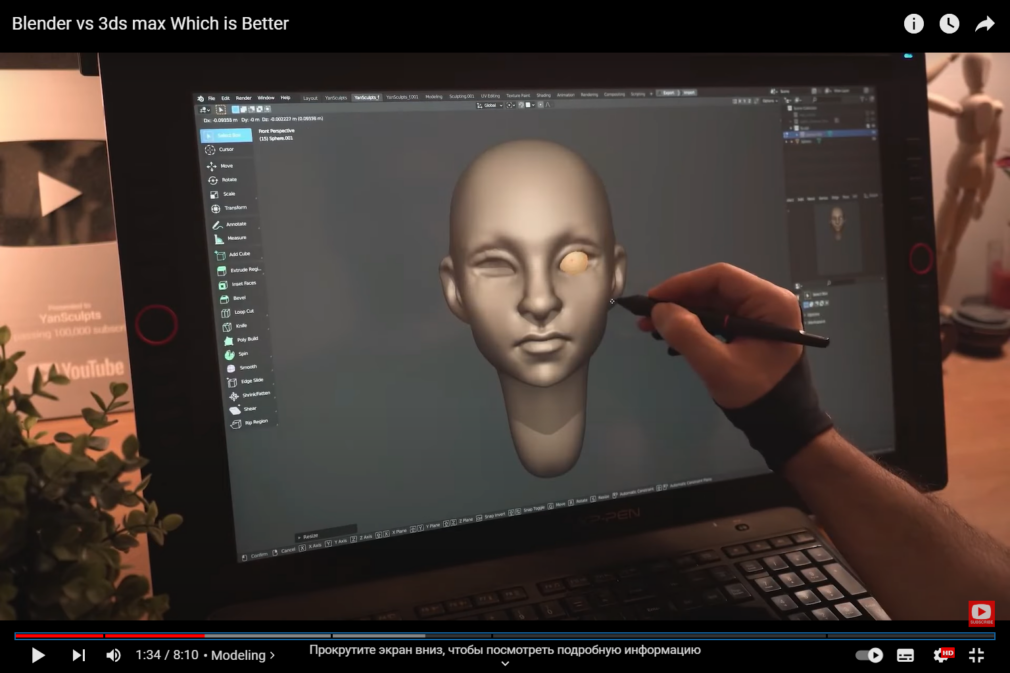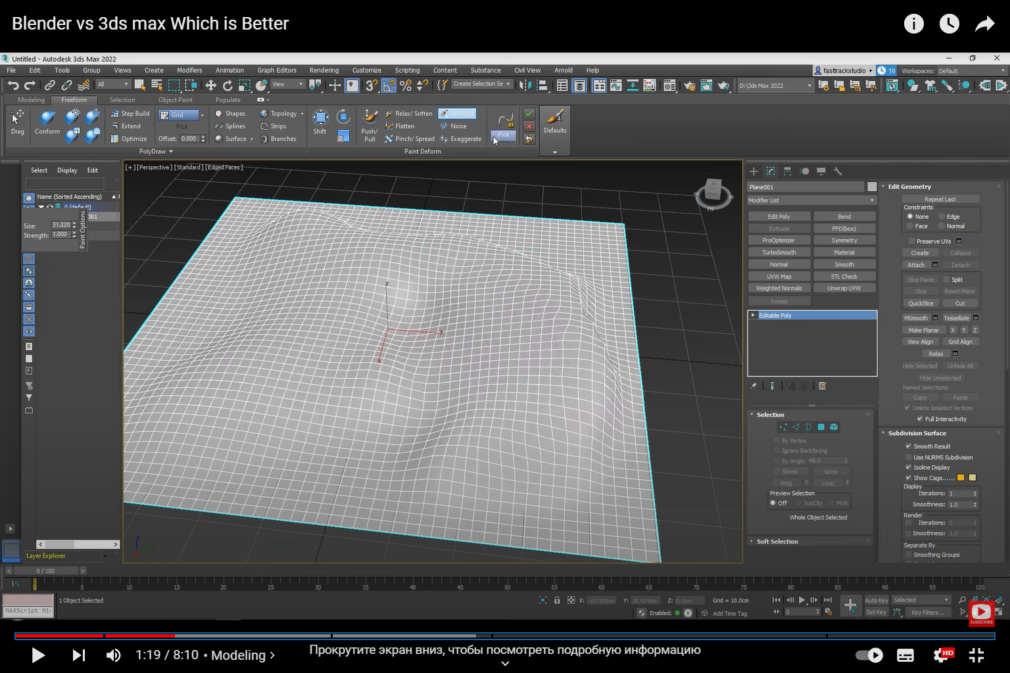When it comes to 3D modeling, two powerful software options stand out: 3Ds Max and Blender. Both have a loyal following and a robust set of features, making the decision of choosing one over the other quite challenging.
What is 3Ds Max?
3Ds Max, developed by Autodesk, is a professional-grade 3D modeling and animation software used extensively in the gaming, film, and architecture industries. It offers a wide range of advanced tools and functionalities, making it a top choice for professionals.
What is Blender?
Blender, on the other hand, is an open-source 3D creation suite, admired for its free availability and active community. Despite being free, it packs a punch and competes fiercely with commercial software in terms of features and capabilities.
Head to Head: 3Ds Max vs. Blender
Let’s delve into the comparison between these two powerful 3D software options:
User Interface and Learning Curve
3Ds Max: The user interface of 3Ds Max is known for its professional look and feel. It might appear intimidating for beginners due to its complexity, but with dedicated effort and proper tutorials, mastering it is achievable.
Blender: Blender’s UI is user-friendly, thanks to recent improvements. It is more accessible for newcomers and less overwhelming. This aspect makes it an attractive option for those just starting with 3D modeling.
Features and Functionality
3Ds Max: As a premium software, 3Ds Max offers a plethora of advanced features for modeling, animation, rendering, and more. Its tools are highly regarded in the industry for their precision and versatility.
Blender: Despite being free, Blender doesn’t compromise on features. It boasts an impressive array of tools for modeling, sculpting, UV unwrapping, animation, and more. The fact that it’s continuously improving through community contributions is an advantage.
Rendering Capabilities
3Ds Max: Known for its powerful rendering engine, 3Ds Max provides photorealistic renders and advanced lighting options. This makes it a top choice for architectural visualization and product rendering.
Blender: Blender’s Cycles renderer has made great strides, offering impressive rendering capabilities. Though it might not be as robust as 3Ds Max’s rendering engine, it’s more than sufficient for most projects.

Industry Adoption
3Ds Max: Due to its long-standing presence in the industry and powerful tools, 3Ds Max is widely used in professional settings for game development, architectural visualization, and visual effects in movies.
Blender: Blender has gained substantial traction in recent years, with notable adoption in indie game development, short film production, and even some professional studios. Its open-source nature has contributed to its rising popularity.
Community and Support
3Ds Max: Autodesk’s 3Ds Max benefits from a large and active community. This translates into abundant tutorials, plugins, and a wealth of online resources to aid learners.
Blender: Blender’s community is its strong suit. With a passionate and helpful community, learners can find immense support, making it easier to overcome hurdles and grow their skills.
Animation Tools Comparison
3Ds Max: This software has a comprehensive set of animation tools, including keyframe animation, rigging, and character animation. Its CAT (Character Animation Toolkit) system is particularly popular for creating advanced character animations.
Blender: Blender excels in animation as well, with a powerful and flexible animation system. Its armature-based rigging and animation tools allow for intricate character animations, and the built-in Grease Pencil tool is a unique feature for 2D animation.
Modeling Workflows
3Ds Max: 3Ds Max offers a range of modeling methods, such as polygonal modeling, NURBS, and spline-based modeling. Its parametric modeling allows for non-destructive editing, making it easier to iterate on designs.
Blender: Blender’s modeling tools are also diverse, with strong support for polygonal modeling and sculpting. Its dynamic topology sculpting is especially popular among artists for organic modeling.
Simulation and Dynamics
3Ds Max: This software provides robust simulation and dynamics tools, suitable for creating realistic physics-based animations. It offers solutions for cloth simulations, particle systems, and dynamic simulations for rigid bodies.
Blender: Blender’s simulation capabilities have grown significantly over the years. It now includes features like cloth simulation, smoke and fire simulation, and fluid simulation, making it a versatile option for various visual effects.

Plugin and Add-on Ecosystem
3Ds Max: Being a commercial software, 3Ds Max benefits from a vast array of third-party plugins and add-ons. These extend the software’s capabilities and offer specialized tools for various industries.
Blender: Blender’s open-source nature has led to a thriving community of developers creating a wide range of add-ons and plugins. Users can enhance Blender’s functionality according to their specific needs.
Feature Comparison
To summarize the key features and differences between 3Ds Max and Blender, here’s a comparison table:
| Features | 3Ds Max | Blender |
|---|---|---|
| User Interface | Professional, complex | User-friendly |
| Price | Commercial, expensive | Free, open-source |
| Rendering | Powerful photorealism | Impressive rendering |
| Industry Adoption | Widely used in industries | Growing professional use |
| Community and Support | Large and active community | Passionate and helpful |
| Animation Tools | Robust, CAT system | Powerful, Grease Pencil |
| Modeling Workflows | Polygonal, NURBS, splines | Polygonal, sculpting |
| Simulation and Dynamics | Cloth, particles, rigid bodies | Cloth, smoke, fluid |
| Plugin Ecosystem | Abundant third-party plugins | Growing add-on support |
Is 3Ds Max Worth The Price?
3Ds Max is available on a subscription basis, with options for monthly, annual, or triennial payments. The cost can exceed a thousand dollars per year, depending on your chosen subscription plan. Given these expenses, the question arises: is it a worthwhile investment? Here are some key considerations:
Blender Preferred by 3D Environment & Character Artists:
Blender is the preferred choice for many 3D environment and character artists. It offers a variety of modifiers similar to those found in 3Ds Max, making it a comparable alternative.
Blender Add-ons Compete with or Excel in Hard Surface Modelling:
For hard surface modelling, Blender’s add-ons are on par with or even superior to those in 3Ds Max.
Blender’s Progress in Modelling and Character Animation:
Blender has been steadily catching up to 3Ds Max in terms of modelling capabilities, and some users have reported an even better experience with it. Additionally, Blender has shown significant growth in character animation development, including advanced rigging features for preparing characters for animation. Notably, Blender was recently used in the production of a Netflix feature film.
3Ds Max for Professional Projects:
On the other hand, 3Ds Max offers a comprehensive character animation toolkit and is often preferred for video game projects and larger-scale endeavors like movies. If you are a professional focusing on modelling or working on significant projects with generous budgets, 3Ds Max might be the optimal choice.
Blender’s Rise in Short Films:
Blender has also gained popularity in the realm of short films, indicating its growing capabilities and potential for various creative projects.
Cost Considerations and Flexibility:
One major advantage of Blender is that it is available for free, making it an incredible bonus for aspiring animators or those on a tight budget. It’s possible to learn both Blender and 3Ds Max, utilizing Blender for free and 3Ds Max through a monthly subscription. This way, you can assess which software aligns better with your goals. For hobbyists, the time invested in learning Blender could be justified by the savings achieved through its free availability.
Making Your Decision
Now that you have a comprehensive understanding of 3Ds Max and Blender, you can make a well-informed decision. Consider your specific needs, budget, and long-term goals in the world of 3D modeling. Whichever software you choose, both 3Ds Max and Blender offer powerful tools and a supportive community to aid you on your creative journey.
Conclusion
In the end, the choice between 3Ds Max and Blender boils down to your specific needs and aspirations. If you’re looking for a professional-grade software with a wide array of features and don’t mind investing financially, 3Ds Max might be the way to go. On the other hand, if you’re just starting or want to explore the world of 3D modeling without spending a dime, Blender offers an impressive package and a supportive community to accompany you on your journey.





